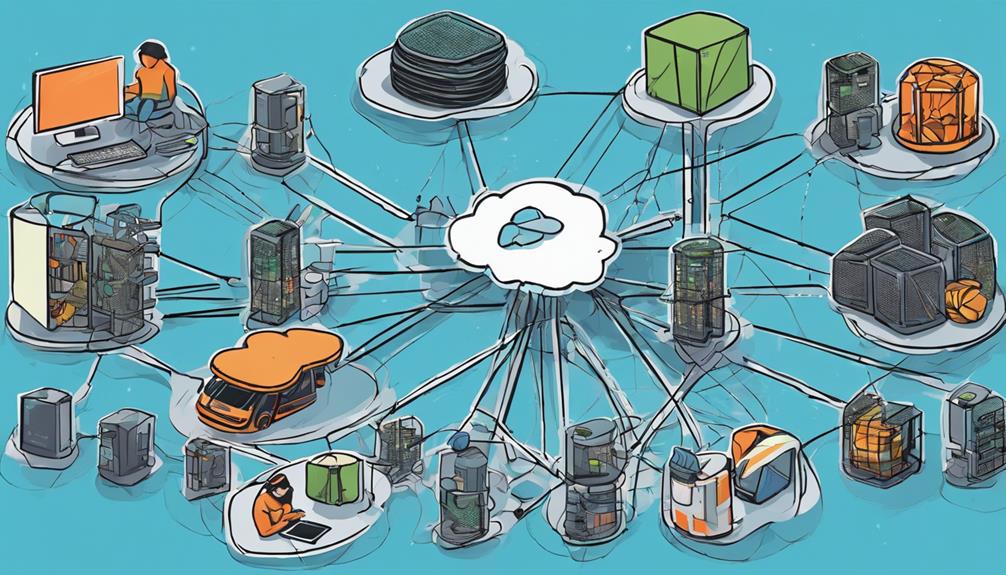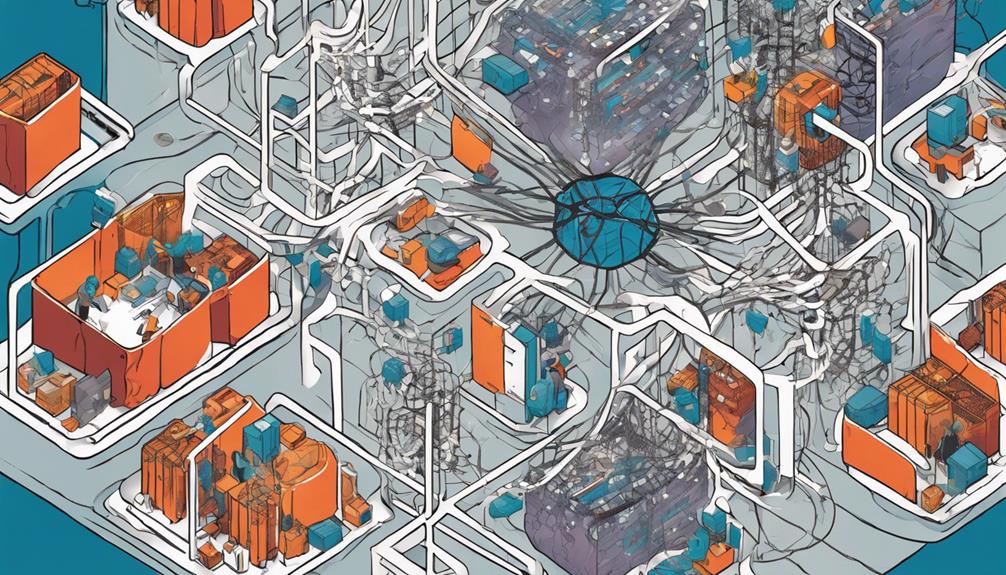In Kubernetes architecture, you have the Control Plane Components managing the cluster and Node Components handling workload execution. Add-ons enhance functionalities like networking, storage, and services. Key services include Service Discovery and ClusterIP support. Kubernetes Networking guarantees efficient communication between components. Persistent Storage with PVs and PVCs offers flexible storage solutions. Kubernetes Helm acts as a package manager simplifying configurations. Learn more about the intricate components shaping Kubernetes and discover best practices for security, efficiency, and governance to maximize performance and integration processes.
Key Takeaways
- Control Plane Components manage cluster state and orchestrate workloads.
- Node Components run containers, manage networking, and interact with the control plane.
- Addons enhance Kubernetes functionality with additional features like DNS and load balancing.
- Kubernetes Services enable communication and load balancing within the cluster.
- Kubernetes Persistent Storage ensures data persistence with various storage solutions.
Control Plane Components
Control plane components in Kubernetes architecture play an essential role in managing and coordinating cluster operations. The kube-apiserver acts as the Kubernetes control plane's front end, exposing the API for communication with other components.
Meanwhile, etcd, a distributed key-value store, stores configuration data and maintains cluster consistency by preserving a centralized state for the cluster.
The kube-scheduler component is responsible for making important scheduling decisions regarding workload placement on nodes within the cluster. It evaluates various factors such as resource requirements, hardware constraints, and policies to optimize the allocation of workloads effectively.
Moreover, the kube-controller-manager oversees the overall state of the cluster, ensuring that the desired state matches the current state.
Additionally, the cloud-controller-manager plays a significant role by incorporating cloud-specific control logic, enabling seamless integration with the cloud provider's API.
Together, these control plane components collaborate to orchestrate and streamline cluster operations efficiently, ensuring the best performance and resource utilization.
Node Components

Nodes in Kubernetes, the worker machines responsible for hosting pods that run containerized applications, are composed of necessary components. The kubelet, an important node component, manages containers on the node, ensuring they're running and healthy.
Another essential component is kube-proxy, which handles network connectivity for containers on the node. For running and managing containers on a node, a Container Runtime like Docker or containerd is indispensable.
Additionally, worker nodes in a Kubernetes cluster require an operating system to function properly within the cluster environment. These components work together seamlessly to support the deployment and execution of containerized applications on the nodes.
Understanding the role each component plays in the node architecture is crucial for maintaining the efficiency and reliability of the Kubernetes cluster's worker machines.
Addons

When it comes to Kubernetes addons, you're about to uncover essential components that can greatly enhance the functionality of your Kubernetes cluster.
These addons play a crucial role in extending the capabilities of your cluster by providing additional tools and functionalities.
Get ready to explore how these addons can empower you to optimize your Kubernetes environment.
Key Kubernetes Addons
Enhance the functionality of your Kubernetes cluster by leveraging key Kubernetes addons. These addons encompass essential components such as the network proxy that runs between services, the Kubernetes controller manager responsible for managing controllers specific to the cluster, and the cloud controller that interacts with the underlying cloud provider.
Additionally, addons like the DNS server guarantee seamless service discovery, while load balancing improves the distribution of traffic across pods. Persistent storage addons enable the storage of data beyond the lifecycle of individual pods, and controllers specific to affinity and anti-affinity specifications help in defining pod placement preferences.
Furthermore, Kubernetes networking addons facilitate efficient communication between cluster nodes, enhancing the overall network performance. By incorporating these key addons into your Kubernetes environment, you can tailor the cluster to meet your specific operational requirements and optimize its functionality.
Enhancing Kubernetes Functionality
Enhance the capabilities of your Kubernetes cluster by integrating various addons to improve its functionality. Kubernetes addons play an essential role in extending cluster functionality.
Monitoring tools like Prometheus and Grafana offer insights into cluster health and performance metrics, aiding in proactive management and troubleshooting.
Logging addons such as Fluentd and Elasticsearch streamline the collection and analysis of container logs, facilitating effective monitoring and debugging processes.
Service mesh addons like Istio enhance microservices communication by providing advanced networking and security features, ensuring seamless and secure interactions between services.
Additionally, storage plugins like CSI drivers enable the utilization of persistent storage solutions for stateful applications within Kubernetes clusters.
Extending Kubernetes Capabilities
To expand the functionalities of your Kubernetes cluster, consider incorporating a variety of addons that cater to different aspects such as monitoring, logging, security, networking, and administration. These optional extensions provide additional capabilities beyond the core components of Kubernetes, allowing you to customize and optimize your cluster for specific needs. Popular addons include Prometheus for monitoring and Fluentd for logging. Below is a table showcasing some common Kubernetes addons:
| Addon | Functionality | Example |
|---|---|---|
| Prometheus | Monitoring | Metrics collection and analysis |
| Fluentd | Logging | Log aggregation and forwarding |
| Traefik | Networking | Ingress controller for routing |
Kubernetes Services

Exploring Kubernetes Services reveals their fundamental role in managing and exposing a group of pods that provide specific services within the cluster. When delving into Kubernetes Services, you encounter the following key aspects:
- Service Discovery: Kubernetes Services enable seamless communication between various parts of an application by abstracting the underlying pod infrastructure and providing a consistent way to access services.
- ClusterIP and NodePort: Kubernetes offers different types of Services for diverse access needs. ClusterIP guarantees internal cluster access, while NodePort allows external access to services running within pods.
- Stable Endpoint for Applications: Kubernetes Services play an important role in networking by providing a stable endpoint for accessing applications. This stability simplifies the process of interacting with pods, ensuring reliable communication within the cluster and beyond.
Understanding the nuances of Kubernetes Services is necessary for effectively managing communication and connectivity within a Kubernetes Architecture.
Kubernetes Networking

Kubernetes Networking operates on a virtual network model where each pod in the cluster is assigned a unique IP address for seamless communication and connectivity. The Container Network Interface (CNI) standardizes pod-to-pod communication, enabling efficient communication within the cluster. Various CNI plugins such as Flannel, Calico, and Weave Net play a crucial role in managing the virtual network and facilitating smooth communication between pods. This setup ensures that containerized applications can interact seamlessly within the cluster. Additionally, PersistentVolumes (PVs) in Kubernetes offer storage resources for containers, ensuring data persistence and availability across cluster nodes.
| Kubernetes Networking Components | Description | Benefits |
|---|---|---|
| Container Network Interface | Standardizes pod-to-pod communication | Ensures consistent network connectivity |
| CNI Plugins | Flannel, Calico, Weave Net | Manage virtual network efficiently |
| Unique IP Addresses | Assigned to each pod for communication | Enables seamless connectivity |
| Persistent Volumes | Provide storage for containers | Ensure data persistence |
| Communication Within Cluster | Facilitates interaction between pods | Enhances cluster-wide connectivity |
Kubernetes Persistent Storage

Persistent storage in Kubernetes involves managing storage resources to guarantee data persistence for applications running within the cluster.
When working with Kubernetes Persistent Storage, you need to understand the following key concepts:
- PersistentVolumes (PVs):
These are storage resources controlled by cluster administrators to offer persistent storage for applications within the Kubernetes cluster.
- PersistentVolumeClaims (PVCs):
Pods make requests through PVCs for storage resources, specifying the required amount and type of storage for the application.
- Storage Types:
Kubernetes supports various storage options for PersistentVolumes, such as network-attached storage (NAS), block storage, and cloud storage solutions. This variety allows for flexibility in choosing the most suitable storage solution for your applications in the Kubernetes cluster.
Kubernetes Helm

When managing applications in a Kubernetes environment, utilizing Kubernetes Helm can greatly simplify deployment processes. Helm functions as a package manager for Kubernetes, allowing users to deploy applications using pre-configured charts.
These charts provide a convenient way to define, install, and upgrade applications within Kubernetes clusters. One of Helm's key features is its support for versioning, enabling efficient management of different application versions.
By abstracting complex Kubernetes configurations into reusable templates, Helm enhances productivity by streamlining the deployment process. Additionally, Helm aids in managing dependencies and sharing configurations, further simplifying application deployment.
Best Practices & Tools

To maximize performance and security in your Kubernetes environment, adopting best practices and leveraging effective tools is critical. Here are some key strategies and tools to enhance your Kubernetes deployment:
- Stay Updated: Regularly updating to the latest Kubernetes version is essential to benefit from security patches and new features, guaranteeing your environment remains secure and efficient.
- Train Your Teams: Providing training for developer and operations teams is essential to make sure they're well-versed in best practices, enabling them to effectively manage Kubernetes environments.
- Implement RBAC and Standardize Governance: Utilize role-based access control (RBAC) to restrict access based on roles and permissions, enhancing security. Standardizing governance and integration processes across teams ensures consistency and efficiency in Kubernetes deployments.
Frequently Asked Questions
What Are the Components in Kubernetes Architecture?
In Kubernetes architecture, various components like kube-apiserver, etcd, kube-scheduler, kube-controller-manager, kubelet, kube-proxy, and container runtime engine work together to manage pods, schedule tasks, store data, and connect to cloud providers.
How Many Components Are in Kubernetes?
In Kubernetes, there are multiple components at play. The control plane houses essential parts like kube-apiserver, kube-scheduler, kube-controller-manager, cloud-controller-manager, and etcd. Worker nodes, managed by Kubelet and Kube-Proxy, host your workloads. Optional extensions add extra functionality.
What Are the Components of Kubernetes Network?
To understand the components of Kubernetes networking, you need to grasp the concept of virtual networks assigning unique IP addresses to pods. The Container Network Interface (CNI) standard, with plugins like Flannel, Calico, and Weave Net, facilitates pod-to-pod connectivity.
What Are Three of the Components of a Kubernetes Master Machine?
When exploring the components of a Kubernetes master machine, you'll discover kube-apiserver, kube-scheduler, and kube-controller-manager. These three vital elements collaborate to maintain the control plane's functionality and oversee cluster operations effectively.
How Do the Different Components of Kubernetes Architecture Utilize the Most Used Kubernetes Tools for Streamlined Operations?
Kubernetes architecture relies on a variety of components, each utilizing the most used kubernetes tools for streamlined operations. For instance, the control plane uses tools like kubectl and kube-apiserver to manage cluster operations, while the node components utilize kubelet and container runtime for pod management and execution.
Conclusion
To sum up, Kubernetes architecture is a complex system made up of various components like the control plane, node components, addons, services, networking, persistent storage, and Helm.
It may seem overwhelming at first, but with the right tools and best practices, you can navigate through it effortlessly.
Kubernetes truly is the backbone of modern cloud-native applications, revolutionizing the way we manage and deploy software.








